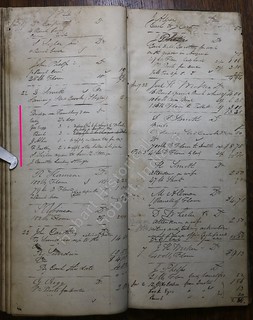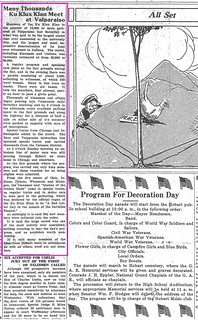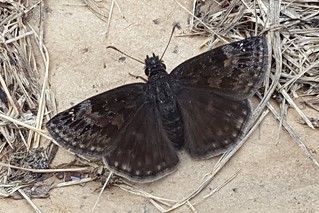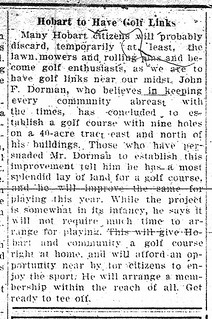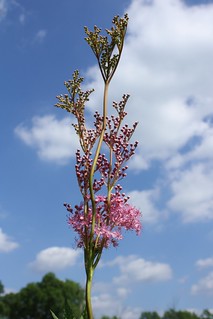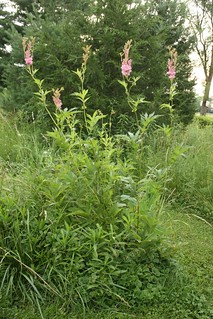I'm glad I came across this page in one of our early ledgers, showing the ledger-keeper during the summer of 1848 somehow getting involved in plans for a new Porter County courthouse and seminary …
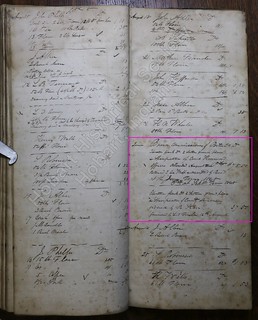 (Click on image to enlarge)
(Click on image to enlarge)
Image courtesy of the Hobart Historical Society.
… because this information motivated me to go looking into
Porter County history to find out if a new courthouse or a seminary had been built in 1848-9. The answer is no, but while poking around there I stumbled across the name of Joel Wicker, which I had seen on other pages of the ledger, so I started looking into
him. That got interesting.
The earliest mention of Joel Hoxie Wicker I've found thus far in the ledgers is May 28, 1847:
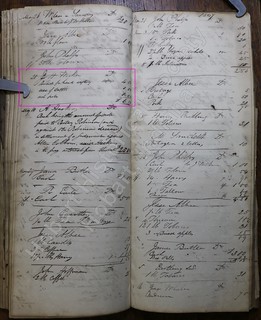 (Click on image to enlarge)
(Click on image to enlarge)
Image courtesy of the Hobart Historical Society.
It is significant that the ledger-keeper first wrote the initial
C, then corrected it to
J, but we'll get to that.
Various Porter County histories make glancing references to Joel Wicker — for example, he was "the first one to expose goods for sale in Deep River, in a building that was owned and just completed by John Wood, Sen."
[1]
We also learn that Joel Wicker married into Porter County's pioneering Bailly family (of the
Bailly homestead). His wife was a daughter of Joseph and Marie Bailly, named Josephine Hortense; she married Joel on July 23, 1849 per the
Indiana Marriage Collection. The
1850 Census shows Joel and Hortense living in Chicago, in a household of other Wickers, only one of whom (a one-month-old infant) could possibly be a child of the marriage. I have no idea how the others were related. Unfortunately, Hortense did not live to be counted in the next census.
According to one former resident of Baillytown, Joel Wicker was more influential in developing that settlement than Joseph Bailly himself — buying some of Bailly's property after his death, operating a sawmill and a store at Baillytown, and recruiting Swedish immigrants from Chicago to come into Porter County, where they worked his sawmill and bought land from him to settle and raise their families.
[2]
Now, remember that
C on the ledger page above? That brings us to Joel's more famous brother, Charles Gustave. The earliest dated reference to him I've found so far in the ledgers is July 10, 1845.
 (Click on image to enlarge)
(Click on image to enlarge)
Image courtesy of the Hobart Historical Society.
We've all heard of the Wicker Park area in Chicago, have we not? Some sources
[3] say it is named after both Charles and Joel Wicker — but only Charles gets a
nine-foot-tall bronze statue! After Charles' death in 1890, someone went to the trouble of writing a fairly detailed and highly flattering biographical sketch;
[4] if Joel ever received such treatment after his death in 1888, I haven't found evidence of it.
Per an entry on findagrave.com, Joel Wicker rests in Graceland Cemetery, Chicago, in
an unmarked grave. As for his wife, who died in 1855, there seems to be some confusion as to whether she is buried in Chicago or in the Bailly Cemetery in Porter County,
[5] but in any case her grave is likewise unmarked.
_______________
[1] A.G. Hardesty, Illustrated Historical Atlas of Porter County, Indiana, Valparaiso, Indiana: A. G. Hardesty (1876), transcribed here; see also Hubert M. Skinner, "Complete History of Porter County, Indiana," Valparaiso Messenger (Valparaiso, Ind.), Jan. 15, 1878, transcribed here.
[2] William T. Ahrendt, quoted in David McMahon, "Rediscovering a Swedish Ethnic Past: The National Park Service and Baillytown, Indiana," Swedish-American Historical Quarterly (Jan. 1997), pp. 26-52, reproduced here.
[3] See, e.g., "How the Neighborhoods Got Their Names" and "Ask Chicagoist: Who Put the 'Wicker' in Wicker Park?"
[4] Wyllys S. Abbot, "Hon. Chas. G. Wicker," Magazine of Western History (Oct. 1890), reproduced digitally here.
[5] See "Bailly Cemetery, Westchester Township."
